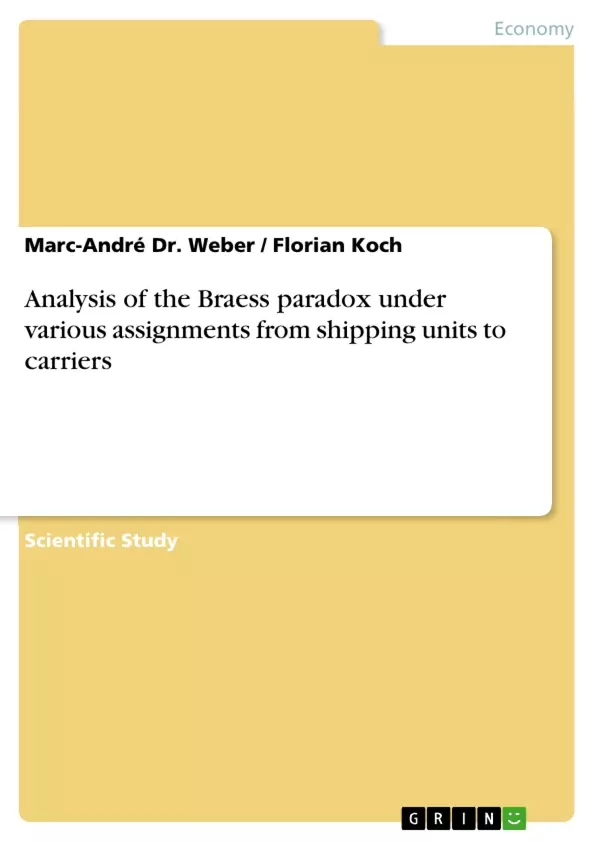The Braess paradox, introduced by D. Braess in 1968, describes the situation in which the total time spent in a system for at least two vehicles travelling from one node to another within a network of several nodes may increase if an additional path is added. This effect is due to non-cooperative behavior of the subjects involved and the fact that time consumption on the paths depends on their respective congestion. In this Game Theoretical paradox, full information is given to all vehicles about the theoretically shortest path for one vehicle, measured in time units, disregarding any congestion, which leads to a routing decision of individual rationality. This paper analyzes the Braess paradox if several shipping units have to be transported by multiple vehicles and load weight influences traffic congestion. A mixed integer linear programming formulation is used to model the problem. We introduce the model in detail, give numerical examples and analyze the results. A brief literature review on previous publications dealing with the Braess paradox is given as well.
Inhaltsverzeichnis (Table of Contents)
- Introduction
- Literature review
- Model formulation
- Notation
- MIP-formulation
- Numerical results
- Description of the case
- Data for the example
- Results
- Discussion
Zielsetzung und Themenschwerpunkte (Objectives and Key Themes)
This paper investigates the Braess paradox in the context of shipping unit transportation. The paradox, first identified by D. Braess in 1968, describes the counterintuitive phenomenon where adding a path to a network can increase the total travel time for all vehicles. This research focuses on the impact of assigning shipping units to carriers and how load weight influences congestion and travel times, resulting in a potential Braess paradox effect.
- Analysis of the Braess paradox under various shipping unit assignments to carriers.
- Impact of load weight on traffic congestion and travel times.
- Development and application of a Mixed Integer Programming (MIP) formulation to model the problem.
- Numerical testing and analysis of the results.
- Discussion of the influence of key parameters like load-based latency costs, number of units, and number of carriers.
Zusammenfassung der Kapitel (Chapter Summaries)
- Introduction: Provides an overview of the Braess paradox and introduces the research problem. It highlights the key aspects of the problem, including the non-cooperative behavior of vehicles and the impact of congestion.
- Literature review: Presents a comprehensive review of existing research on the Braess paradox. It covers various aspects like network design, stochastic traffic assignments, and applications in data and communication networks.
- Model formulation: Introduces the model framework using Mixed Integer Programming (MIP). It defines the notation, input parameters, decision variables, and dependent variables. The model aims to minimize the total latency in the system by assigning vehicles to specific arcs while accounting for individual vehicle decision-making and congestion effects.
- Numerical results: Discusses the numerical experiments conducted using the proposed MIP model. It describes the case study, presents the data used, and provides detailed analysis of the results. The focus is on analyzing the occurrence of the Braess paradox under different conditions.
- Discussion: Provides a comprehensive analysis of the results from the numerical experiments. It explores the influence of various parameters, such as load-based latency costs, number of units to be transported, and the number of trucks available, on the occurrence of the Braess paradox.
Schlüsselwörter (Keywords)
The primary keywords and focus topics include: Braess Paradox, Mixed Integer Linear Programming, Game Theory, Truck Assignment, Load-dependent Travel Times, Shipping Unit Distribution, Network Optimization, Congestion Effects, and Vehicle Routing.
- Quote paper
- Marc-André Dr. Weber (Author), Florian Koch (Author), 2014, Analysis of the Braess paradox under various assignments from shipping units to carriers, Munich, GRIN Verlag, https://www.grin.com/document/280983



